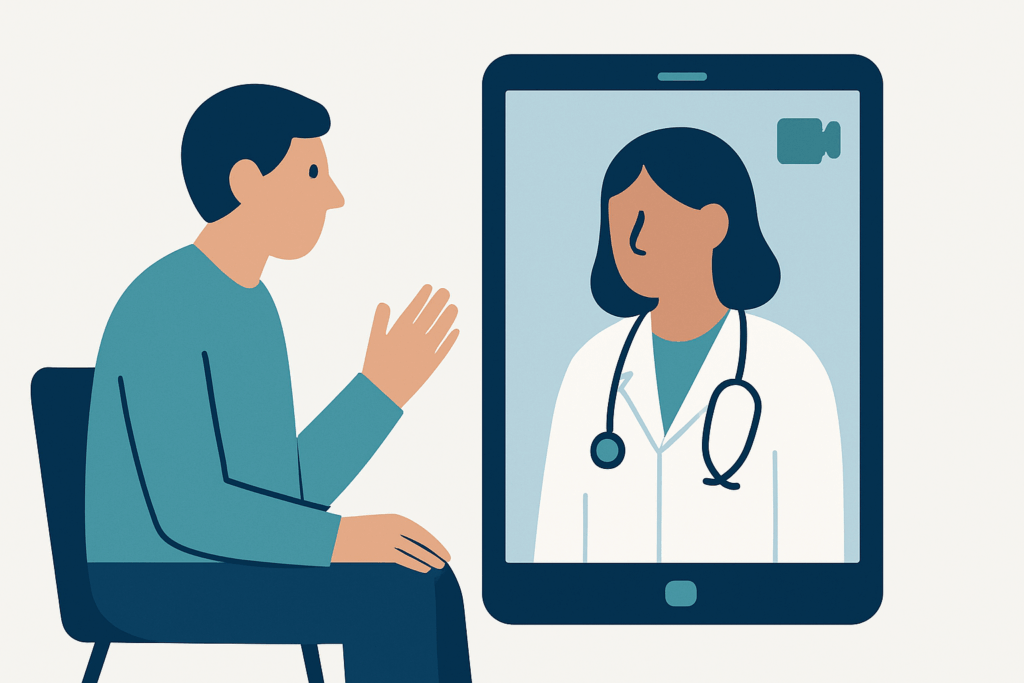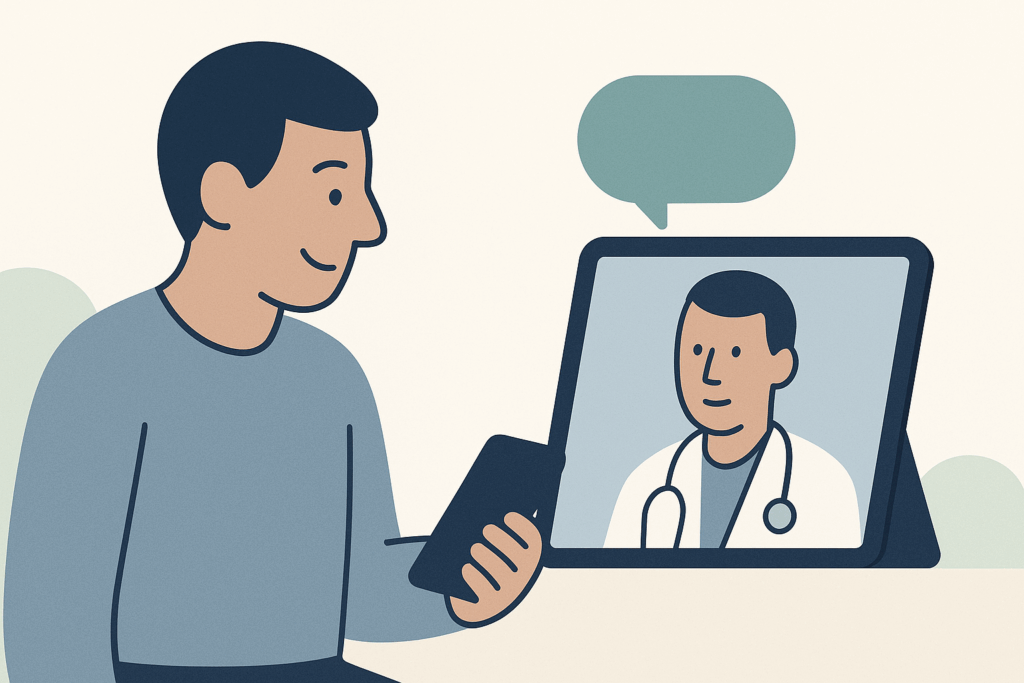Overview
Virtual healthcare has evolved from a convenient option to an essential service, offering five key benefits: unmatched convenience and accessibility, reduced exposure to illness, significant time and cost savings, expanded access to specialists regardless of location, and improved continuity of care with lower no-show rates. While not suitable for all medical situations, video doctor visits excel for follow-up appointments, mental health consultations, medication management, and minor illnesses, making healthcare more accessible and patient-centered while complementing traditional in-person care.
Table of Contents
In recent years, virtual healthcare has transformed from a convenient option to an essential service in our healthcare system. The ability to consult with a doctor through video calls has revolutionized how patients access medical care, particularly since 2020 when the COVID-19 pandemic forced healthcare providers to adapt quickly. At Dr Telx, we’ve witnessed firsthand how telemedicine has become a cornerstone of modern healthcare delivery. While face-to-face appointments remain crucial for certain conditions, video doctor visits offer remarkable benefits that are worth exploring for many healthcare needs.
Benefit #1: Unmatched Convenience and Accessibility
Perhaps the most obvious advantage of video doctor visits is the sheer convenience they provide. Instead of arranging transportation, finding parking, and sitting in waiting rooms, patients can connect with healthcare providers from the comfort of their homes. This accessibility is revolutionary for various groups of people:
For busy professionals, a lunch break can now accommodate a doctor’s appointment without losing half a workday. Parents no longer need to arrange childcare or bring children along to appointments. For older adults or people with mobility challenges, virtual visits eliminate the physical strain of traveling to medical facilities.
One of our patients, Sarah, lives in a rural community about 45 miles from the nearest primary care office. Before telemedicine, a simple follow-up appointment meant a half-day commitment. Now, she manages her chronic condition through regular video visits with her doctor, saving hours of travel time each month while maintaining consistent care.
Benefit #2: Reduced Exposure to Illness
Traditional medical waiting rooms can inadvertently become gathering places for contagious illnesses. For people with compromised immune systems or chronic conditions, this exposure presents a significant risk. Virtual healthcare eliminates this concern entirely.
According to a 2022 study published in the Journal of Medical Systems, patients who utilized telemedicine services during flu season reported 67% fewer respiratory infections compared to those who regularly attended in-person appointments. This benefit extends beyond protecting individual patients—it helps reduce the community spread of contagious diseases by keeping symptomatic patients at home while still providing them with necessary care.
For families with young children or those caring for elderly relatives, this reduced exposure risk provides peace of mind beyond measure.

Benefit #3: Time and Cost Savings
The financial benefits of virtual healthcare extend beyond the obvious. While many insurance plans now cover telemedicine visits at similar rates to in-person care, the peripheral costs are significantly reduced:
- No transportation expenses (gas, parking, public transit fees)
- No need to take excessive time off work (reducing lost wages)
- Reduced childcare requirements
- Lower exposure to additional illnesses (potentially preventing future medical costs)
At Dr Telx, our analysis shows the average patient saves approximately $43 in direct costs per telemedicine visit compared to in-person appointments, not including the value of time saved. For those managing chronic conditions requiring frequent check-ins, these savings accumulate substantially over time.
A typical 15-minute consultation might actually consume 2-3 hours of a patient’s day when accounting for travel and waiting room time. Virtual visits return this valuable time to patients, allowing for minimal disruption to daily responsibilities.
Benefit #4: Expanded Access to Specialists
One of the most transformative aspects of video healthcare is how it democratizes access to specialized medical expertise. For many Americans, seeing a specialist might traditionally require traveling to a major medical center, sometimes hundreds of miles away.
Virtual care breaks down these geographical barriers. A patient in a small town can now consult with a dermatologist, neurologist, or endocrinologist practicing at a prestigious institution across the state—or even across the country.
This expanded access has tangible outcomes. Wait times for specialist consultations have decreased in many fields. For example, the average wait time for a dermatology appointment nationally is 32 days, but many telemedicine platforms can connect patients with specialists within a week.
Michael, a Dr Telx patient living with a rare autoimmune condition, now consults regularly with a specialist who previously would have required a four-hour drive each way. His health outcomes have improved significantly with more consistent specialized care.
Benefit #5: Improved Continuity of Care
Virtual visits remove many barriers that typically prevent patients from attending follow-up appointments, resulting in better adherence to treatment plans and improved outcomes.
The ease of logging in for a quick check-in makes patients more likely to keep these crucial appointments. According to healthcare analytics firm Advisory Board, no-show rates for virtual follow-ups are typically 50% lower than for in-person appointments.
Telemedicine also facilitates integration with remote monitoring technologies. Patients with conditions like diabetes or hypertension can share data from home monitoring devices directly with their healthcare providers, enabling more responsive care adjustments. Medication management becomes more effective as well, with providers able to quickly address side effects or efficacy concerns without waiting for the next scheduled in-person visit.
At Dr Telx, patients enrolled in our virtual chronic care program demonstrate a 34% improvement in medication adherence compared to traditional care models.

When Virtual Visits Work Best
While the benefits are substantial, telemedicine isn’t appropriate for every medical situation. Virtual healthcare excels for:
- Follow-up appointments for stable chronic conditions
- Mental health consultations
- Medication management
- Minor illnesses and infections
- Skin conditions visible on camera
- Pre-surgical consultations and post-operative follow-ups
In-person care remains essential for:
- Physical examinations requiring hands-on assessment
- Emergency situations
- Diagnostic procedures and tests
- Complex new conditions requiring multiple physical assessments
Most healthcare providers now embrace a hybrid model, using virtual care when appropriate while maintaining in-person capabilities for situations requiring physical presence.
The Future of Healthcare Is Connected
The five essential benefits we’ve explored—convenience, reduced illness exposure, cost savings, specialist access, and improved continuity of care—demonstrate why virtual healthcare has become a permanent fixture in our medical landscape.
At Dr Telx, we believe the future of healthcare lies in thoughtfully blending virtual and in-person care to create the most accessible, effective, and patient-centered experience possible. The technology continues to evolve, with improvements in remote monitoring devices, integration with electronic health records, and enhanced video capabilities making the virtual experience increasingly seamless.
Ready to experience these benefits firsthand? Most health insurance plans now cover telemedicine visits, and getting started is simpler than you might think. Contact your primary care provider to ask about their virtual visit options, or explore dedicated telemedicine providers like Dr Telx that specialize in video consultations.
Your next healthcare appointment could be just a few clicks away—no travel required, no waiting room necessary, just quality care delivered directly to you.
Frequently Asked Questions
Are video doctor visits covered by insurance?
Yes, most major insurance providers now cover video doctor visits similarly to in-person appointments. This coverage expanded significantly during the COVID-19 pandemic, and many insurers have maintained their telehealth benefits. However, coverage details vary by plan and provider, so it’s always best to check with your specific insurance company before scheduling a virtual appointment. Many platforms can verify your coverage before your consultation.
What equipment do I need for a video doctor visit?
The basic requirements for a video doctor visit are simple: a device with a camera and microphone (smartphone, tablet, or computer), a reliable internet connection, and a quiet, private space. Most telemedicine platforms work through web browsers or dedicated apps that are easy to download. You don’t need professional equipment – the camera and microphone built into most modern devices are sufficient for a quality consultation.
Can doctors prescribe medication during virtual visits?
Yes, doctors can prescribe many medications during video doctor visits. They can send prescriptions electronically to your preferred pharmacy just as they would after an in-person visit. However, there are restrictions on prescribing controlled substances virtually, though some exceptions exist under certain conditions. Your provider will inform you if your medication needs require an in-person appointment.
How secure and private are video doctor visits?
Legitimate telemedicine platforms use secure, encrypted connections that comply with HIPAA (Health Insurance Portability and Accountability Act) requirements. This means your medical information and the content of your video consultation remain private and protected. Healthcare providers are required to use platforms specifically designed for healthcare to ensure patient privacy. It’s important to conduct your visit in a private location and use a secure internet connection for additional security.
Can I see my regular doctor for a video visit?
Many primary care physicians and specialists now offer video visits as part of their regular practice. If you have an established relationship with a healthcare provider, ask their office about virtual appointment options. If your regular doctor doesn’t offer telemedicine services, many healthcare systems provide access to their network of providers through virtual platforms, allowing for continuity of care within the same health system. Electronic medical records often make it possible to share information between your virtual provider and your regular physician.

